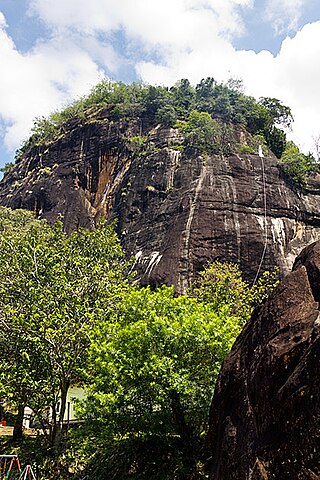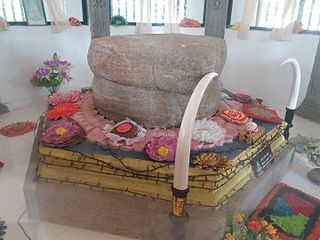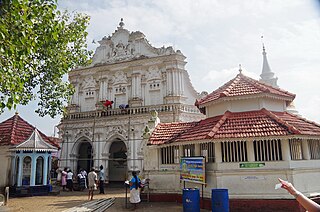
The Kandy Esala Perahera also known as The Festival of the Tooth is a festival held in July and August in Kandy, Sri Lanka. This historical procession is held annually to pay homage to the Sacred Tooth Relic of Buddha housed at the Sri Dalada Maligawa in Kandy. A unique symbol of Sri Lanka, the procession consists of traditional local dances such as fire dances and performances in whip-dance garments. The festival ends with the traditional Diya-kepeema ritual, a water cutting ceremony which is held at the Mahaweli River at Getambe, Kandy.

The Tissamaharama Raja Maha Vihara is an ancient Buddhist temple in Tissamaharama, Southern Province of Sri Lanka. It was one of the four major Buddhist monasteries established in Sri Lanka, after the arrival of Arhant Mahinda Thera to the country. The site of the Tissamaharama Raja Maha Vihara was consecrated by Buddha himself, who spent some time in meditation there with 500 arhats, during his third visit to the island. Tissamaharama monastery had been recognized as a pre-eminent Buddhist educational center of the southern Sri Lanka from the 3rd century B.C. to the 11th century A.D. The Tissamaharama Dagoba which is situated in the premises of the monastery is one of the largest stupas in Sri Lanka. The present chief incumbent of Tissamaharama Raja Maha Vihara is Ven. Devalegama Dhammasena Nayaka Thera.

The Temple of the Sacred Tooth Relic or Sri Dalada Maligawa, is a Buddhist temple in Kandy, Sri Lanka. It is located in the royal palace complex of the former Kingdom of Kandy, which houses the relic of the tooth of the Buddha. Since ancient times, the relic has played an important role in local politics because it is believed that whoever holds the relic holds the governance of the country. The relic was historically held by Sinhalese kings. The temple of the tooth is a World Heritage Site mainly due to the temple and the relic.

Seruwawila Mangala Raja Maha Vihara is an ancient Buddhist temple in Trincomalee district in Eastern Province, which is among the sixteen or seventeen holiest Buddhist shrines (Solosmasthana) in Sri Lanka.

Ridi Viharaya or Silver Temple is a 2nd-century BCE Theravada Buddhist temple in the village of Ridigama, Sri Lanka. Built during the reign of Dutthagamani of Anuradhapura, the temple is considered as the place where the silver ore, which provided silver to complete Ruwanwelisaya; one of the largest stupa in Sri Lanka, was discovered. According to the chronicles Mahavamsa and Thupavamsa, the Ridi Viharaya complex was built in gratitude for helping him cherish his dream of completing Ruwanwelisaya.

Bellanwila Rajamaha Viharaya is a Buddhist temple situated in Bellanwila, Colombo District, Sri Lanka. Located around 12 km south to the Colombo city, near Dehiwala - Maharagama road, the temple attracts hundreds of devotees daily and is famous for its annual Esala Perehera festival which usually takes place in the month of August or September. One of the most venerated Buddhist temples in Sri Lanka, many devotees flock to worship the sacred Bo tree of Bellanwila Rajamaha Vihara, which is considered to be one of the first offshoots of Jaya Sri Maha Bodhi in Anuradhapura, Sri Lanka. The present chief incumbent of Bellanwila Rajamaha Vihara is Ven. Dr. Bellanwila Dhammaratana Nayaka Thera.

Mulkirigala Raja Maha Vihara is an ancient Buddhist temple in Mulkirigala, Sri Lanka. It has been built on a 205 m (673 ft) high natural rock, surrounded with another four rocks known as Benagala, Kondagala, Bisogala and Seelawathiegala. The temple site is located about 2 km (1.2 mi) from the Mulkirigala junction and can be reached from either Dikwella or Tangalle towns. The temple has been formally recognised by the Government as an archaeological site in Sri Lanka. The designation was declared on 8 April 1988 under the government Gazette number 501.

Maha Saman Devalaya or the Great Saman Temple is a shrine dedicated to deity Saman, situated at Ratnapura, Sri Lanka who is the presiding deity of the Sri Pada Mountain which is also called Samanthakuta meaning the mountain of Saman which is believed to have the left foot impression of Buddha which he kept in his visit to Sri Lanka.

Maligatenna Raja Maha Vihara is an ancient Cave temple located in Malwatuhiripitiya village, Gampaha District, Sri Lanka. The temple is located on the Gampaha-Wathurugama Road and approximately 1.6 km (0.99 mi) away from the ancient temple Pilikuththuwa Raja Maha Vihara.

Delgamuwa Raja Maha Vihara is an ancient Buddhist temple situated in Kuruvita of Ratnapura District, Sri Lanka. This temple is reputed as the hiding place of the tooth relic of Buddha during the ruling period of Portuguese in the country.

Kasagala Raja Maha Vihara is an ancient Buddhist Temple, situated in Angunukolapelessa, Hambantota District, Sri Lanka. It is situated about 10 km (6.2 mi) away from Ranna Junction along Ranna - Weeraketiya road. The temple has been formally recognised by the Government as an archaeological site in Sri Lanka. The designation was declared on 6 June 2008 under the government Gazette number 1553.

Kande Vihara is a major Buddhist temple in Kalutara District, Sri Lanka. The temple has got its name 'Kande vihara' as it is built on top of a hill located near to Aluthgama town. The temple has been formally recognised by the Government as an archaeological site in Sri Lanka.

Sri Subodharama Raja Maha Vihara is a historic Buddhist temple situated at Dehiwala in the Western province, Sri Lanka. The temple is located at the Dehiwala junction on the Colombo-Galle main road, about 9 miles south of Colombo city. The temple has been formally recognised by the Government as an archaeological site in Sri Lanka. The designation was declared on 23 February 2007 under the government Gazette number 1486.

Balapokuna Raja Maha Vihara is a historic Buddhist temple situated in Pamankada, Western Province, Sri Lanka. It is located near to the 6th mile post junction on Colombo-Batticaloa main road. The temple has been formally recognised by the Government as an archaeological site in Sri Lanka. The designation was declared on 6 June 2008 under the government Gazette number 1553.

Aramanapola Raja Maha Vihara or Ganegama Rankoth Vihara is an ancient Buddhist temple in Ganegama, Sri Lanka. The Vihara is located approximately 2.5 km (1.6 mi) far away from the Pelmadulla town on Colombo - Batticaloa main road (A4). The temple has been formally recognised by the Government as an archaeological site in Sri Lanka. The designation was declared on 2 March 1951 under the government Gazette number 10217.

Malwathu Maha Viharaya is a Buddhist monastery located in Kandy, Sri Lanka. It is the headquarters of the Malwatta chapter of Siyam Nikaya and one of the two Buddhist monasteries that holds the custodianship of sacred tooth relic of Buddha kept in Sri Dalada Maligawa, Kandy. The chief incumbent of the Malwathu Maha Viharaya is the Mahanayaka thero of Malwatta chapter of Siyam nikaya, a leading Buddhist monastic fraternity in Sri Lanka. The present chief incumbent of Malwathu Maha Viharaya is Thibbatuwawe Sri Siddhartha Sumangala Thero.
Asgiri Maha Viharaya is a Buddhist monastery located in Kandy, Sri Lanka. It is the headquarters of the Asgiriya chapter of Siyam Nikaya, one of the two Buddhist monasteries that holds the custodianship of sacred tooth relic of Buddha kept in Sri Dalada Maligawa, Kandy. The chief incumbent of the Asgiri Maha Viharaya is the Mahanayaka thero of Asgiri chapter of Siyam nikaya, a leading Buddhist monastic fraternity in Sri Lanka. The present chief incumbent of Asgiri Maha Viharaya is Warakagoda Sri Gnanarathana Thero. Asgiri Maha Vihara traces its origin from the Wanavasi sect of the Dimbulagala forest monastery of Polonnaruva. Currently, 565 Buddhist temples in Sri Lanka function under Asgiri Viharaya of Kandy.

Sri Maha Bodhi Viharaya is a Theravada Buddhist temple in Kandy, Sri Lanka. It is located in Bahirawakanda, approximately 2 km (1.2 mi) from the city centre. The temple is known for its giant Buddha statue. The statue of Buddha is depicted in the position of the Dhyana Mudra, the posture of meditation associated with his first Enlightenment, and can be seen from almost everywhere in Kandy. It stands at 26.83 m (88.0 ft) high and is one of the tallest Buddha statues in Sri Lanka.

The Kandyan period covers the history of Sri Lanka from 1597–1815. After the fall of the Kingdom of Kotte, the Kandyan Kingdom was the last Independent monarchy of Sri Lanka. The Kingdom played a major role throughout the history of Sri Lanka. It was founded in 1476. The kingdom located in the central part of Sri Lanka managed to remain independent from both the Portuguese and Dutch rule who controlled coastal parts of Sri Lanka; however, it was colonised by the British in 1815.




















